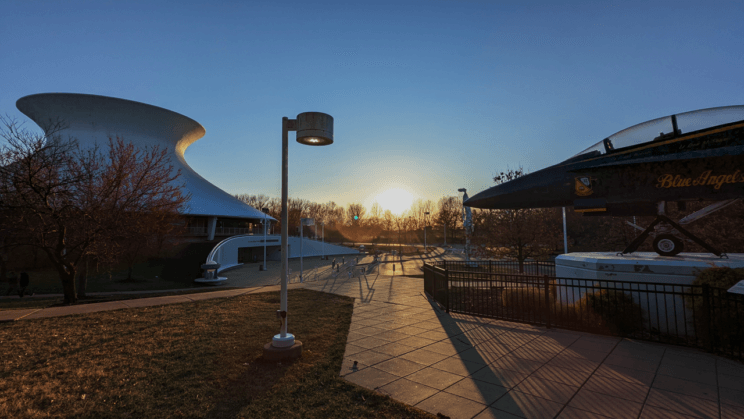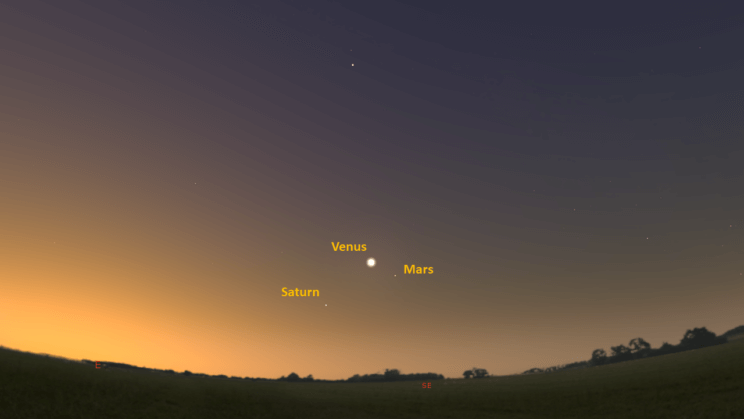This is the Saint Louis Science Center’s NIGHT SKY UPDATE for the week of Friday, March 18, 2022.
Information updated weekly or as needed.
Times given as local St. Louis time which is Central Daylight Time (CDT). For definitions of terminology used in the night sky update, click the highlighted text. If relying on times posted in Universal Time (UT), St. louis is -5 hours when CDT.
Public Telescope Viewings
With the changing recommendations from the CDC regarding COVID-19, conversations regarding the return of star parties at the Saint Louis Science Center have begun. We are close to bringing back our public telescope viewings, but a few details still need to be worked out. We will post future updates as we learn more about when we can bring back telescope viewings.
Observing Highlight of the Week

The setting Sun seen from outside the James S. McDonnell Planetarium on March 19, 2022. Image credit EG.
On March 20, 2022, at 10:33 a.m., the vernal equinox occurs marking the start of astronomical spring. On this day the Sun will cross the celestial equator at its ascending node which means days will grow longer and nights shorter. The term equinox translates to equal night indicating it is a day with equal hours of day and night. This is not entirely true as determining the time of sunrise and sunset is not a straightforward venture. The main complication is Earth’s atmosphere. As light enters the atmosphere it is distorted in different ways. Due to atmospheric refraction, the Sun can appear 0.5° higher than it is. The day that is truly equal hours of day and night is called equilux which usually occurs a few days before the spring equinox and a few days after the fall equinox. Even though day and night will not be equal in length on the vernal equinox, the difference will be small.
An equinox occurs the moment the Sun appears to cross the celestial equator. To understand this behavior, we need to understand the ecliptic. Each year the Sun appears to follow a path through the zodiac constellations called the ecliptic. Because Earth’s axis of rotation is tilted 23.5°, the plane of the ecliptic is tilted with respect to the celestial equator. The result is the Sun appears north of the celestial equator after the vernal equinox and south of the celestial equator after the autumnal equinox. These crossing points are the ascending and descending nodes. Because the Sun crosses the ascending node on the vernal equinox, the Sun will appear higher in the sky increasing the amount of daytime.
Humanity has a long history of observing the spring equinox as it indicates the start of growing season. The ability to track the seasons has long been connected to our knowledge of the sky and how it changes. Stonehenge in England, Woodhenge at Cahokia Mounds and Chankillo in Peru are great examples of how ancient cultures observed astronomical objects. You can make similar observations using a nearby building or stick placed in the ground.
The easiest method to study the Sun’s annual shift is to use a gnomon. This can be anything with vertical relief, the simplest being a stick. If you place a stick in the ground perpendicular to the ground level, you can watch how the shadow cast by the gnomon changes through a day or year. Sundials work in a similar way.
You can also use a building to track the Sun’s annual shift. If you note the Sun’s position to a building at its rise or set points or when the Sun is at local noon; you can see how the Sun’s position varies through the seasons.
Observing the Sun’s annual motions is an ancient tradition which impacted the growth of civilization. It is still a big part of our lives today whether we know it or not. Stepping outside on March 20, 2022, I would encourage all to take time and note the Sun’s position as it sets due west. For the next three months, the Sun’s setting point will shift north until summer begins in June.
The Sun and Moon

The Moon as seen from the International Space Station, on July 31, 2011.
Credit: NASA
Sunrise is at 7:07 a.m. on Friday, March 18 and sunset is at 7:11 p.m. providing us with roughly 12 hours of daylight. Even after sunset, the light from the Sun will dimly illuminate our sky for roughly 1 hour and 30 minutes. This period is called twilight, which ends around 8:40 p.m. this week. For those with a sundial, local noon occurs around 13:08 p.m. this week.
| Day | Sunrise | Sunset |
|---|---|---|
| 2022-03-18 | 7:07 a.m. | 7:11 p.m. |
| 2022-03-19 | 7:06 a.m. | 7:12 p.m. |
| 2022-03-20 | 7:04 a.m. | 7:13 p.m. |
| 2022-03-21 | 7:03 a.m. | 7:14 p.m. |
| 2022-03-22 | 7:01 a.m. | 7:15 p.m. |
| 2022-03-23 | 6:59 a.m. | 7:16 p.m. |
| 2022-03-24 | 6:58 a.m. | 7:17 p.m. |
| 2022-03-25 | 6:56 a.m. | 7:18 p.m. |
| 2022-03-26 | 6:55 a.m. | 7:18 p.m. |
Moon
Moonrise for Friday, March 18 occurred at 7:48 p.m. and moonset will occur at 8:02 a.m. on the following day. On Friday, March 18 the Moon will exhibit a full moon phase with 100% of the lunar disk illuminated. Full moon occurs on March 18, 2022, at 2:18 a.m.
International Space Station (ISS) Observing

Visible passes of ISS from St. Louis for the week of March 18 occur during evening hours. The best pass this week occurs on the evening of March 18. Use the table below for information about this and other visible passes this week.
Catch ISS from St. Louis starting Friday, March 18
| Date | Starts | Max. altitude | Ends | |||||||
|---|---|---|---|---|---|---|---|---|---|---|
| Time | Alt. | Az. | Time | Alt. | Az. | Time | Alt. | Az. | ||
| 18 Mar | -3.6 | 20:06:39 | 10 | SW | 20:10:00 | 76 | NW | 20:13:11 | 11 | NE |
| 18 Mar | -0.6 | 21:45:08 | 10 | WNW | 21:46:10 | 14 | NW | 21:46:10 | 14 | NW |
| 19 Mar | -1.4 | 20:56:32 | 10 | WNW | 20:59:09 | 20 | NNW | 21:00:43 | 15 | N |
| 20 Mar | -1.9 | 20:08:05 | 10 | W | 20:11:05 | 29 | NNW | 20:14:05 | 10 | NNE |
| 22 Mar | -1 | 20:10:10 | 10 | WNW | 20:12:18 | 16 | NNW | 20:14:27 | 10 | NNE |
Magnitude (Mag): The Measure of brightness for a celestial object. The lower the value is, the brighter the object will be.
Altitude (Alt): The angle of a celestial object measured upwards from the observer’s horizon.
Azimuth (Az): The direction of a celestial object, measured clockwise from an observer’s location with north being 0°, east being 90°, south being 180° and west being 270°.
For information about ISS flyovers and other visible satellites, visit www.heavens-above.com
Detailed information regarding all unmanned exploration of our universe, missions past, present, and planned, can be found at Jet Propulsion Laboratories:
The Visible Planets

Looking southeast at 6:40 a.m. March 19, 2022. Credit: Stellarium, EG
This week, three naked eye planets are visible. Venus, Mars and Saturn are seen in the southeast before sunrise.
Venus
Venus has started a morning apparition and will be seen in the southeast before sunrise. Venus rises at 4:58 a.m. and should be easy to spot in the southeast by 5:40 a.m. Venus reaches greatest western elongation on March 26. This morning apparition lasts until the third week of October 2022. Venus reaches superior conjunction on October 22, 2022.
Mars
A new apparition for Mars has begun. Mars rises at 5:06 a.m. Start looking for Mars around 5:40a.m. as it clears trees and buildings. Mars will continue to climb out of the Sun’s glare as it heads towards opposition later this year on December 7, 2022.
Saturn
Saturn has started its apparition for 2022. You can find Saturn in the southeast about 30 minutes before sunrise. You will need a clear view of the horizon to spot Saturn.
James S. McDonnell Planetarium
Night Sky Update: March 18 – March 26, 2022






